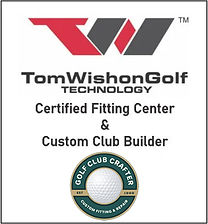
How It Began
I first took up golf during my Navy career, around 1982, when I realized my Fast Pitch Softball skills were starting to fade. One day, my neighbor invited me out to play, and I was hooked the very first time I caught one on the sweet spot. By the
Dan Armstrong, GCA Accredited Mastercraftsman and Advanced Professional Clubmaker
time I retired from the Navy in 1990, I had worked my way down to an 11 handicap. My submarine was homeported in San Diego when I retired, and I decided to stay in the area, taking a job with the County of San Diego.
Then, probably around 1997, I went out as a single at the Miramar Naval Air Station Golf Course in San Diego (now the Marine Corps Air Station). I got paired up with this young fella who had the strangest-looking driver I’d ever seen. Standing on the first tee, it looked almost as long as he was tall...okay, maybe a slight exaggeration, but not by much! When I looked closer, there wasn’t even a ferrule on it, just a gob of dried epoxy that had oozed out of the hosel and hardened there. I remember thinking, what on earth is that thing? When he finally managed to catch one solid, I’ll admit , it went a long way. Problem was, it just never seemed to land in the fairway!
After a couple holes I casually asked him where he got the driver. He proudly replied that he made it himself. He said he went to Golfsmith to buy a driver and discovered they also sold golf club heads and shafts for half the cost of new brand name drivers. So, he bought a head and shaft and glued them together and installed a grip. Obviously, he didn't do any shaft trimming as the driver had to be at least 50 inches long!While the clubhead and shaft looked like quality components, they were clearly not assembled correctly, and I wondered if they would perform like an OEM driver if they had been assembled by a real
craftsman. I was curious, so I stopped by the Golfsmith Store on my way home. I went over to the component section and started looking at all the heads they had on display along with the available graphite shafts and grips. I was intrigued, so I bought a 9° Snake Eyes Fire Forged Driver head, a Graffaloy Pro-Lite "S" Graphite Shaft, a Tour Velvet grip, some grip tape/solvent and a ferrule (didn't want to forget the ferrule) and some golf club epoxy. I figured there was probably a right way AND a wrong way to put the components together, so I also purchased a book entitled "The Golfsmith Practical Clubfitting Program" by Tom Wishon.
After reading the book, I assembled the driver and was extremely pleased with the result. That experience sparked a deeper curiosity, and I soon found myself studying everything I could about golf club design, fitting, and construction. Within a few months, I took the Golf Clubmakers Association (GCA) Professional Clubmaker certification exam offered by Golfsmith, passed, and earned my first formal accreditation.
The path I’ve followed since that day, more than 28 years ago at Miramar Naval Air Station Golf Course, is outlined below.
1999: I enrolled in the 4-day Complete Clubmakers Training School at Golfsmith Headquarters in Austin, Texas. I then opened a shop out of my home in San Diego, CA and created my first website under the business name "Golf Club Crafter".
2001: I enrolled in the 2-day Golfsmith Advanced Clubfitting and Repair School at Golfsmith Headquarters and was awarded the GCA Advanced Professional accreditation after successfully completing the course.
2002: After retiring from my position with the County of San Diego, I returned to my home state of Oregon and opened a full-time Custom Fitting and Repair Shop at an outdoor mall in Cottage Grove. I operated under the name Custom Golf Studio, as there was already a well-established custom golf shop about 18 miles north in Eugene called Clubcrafters.
2003: I enrolled in the inaugural Golfsmith Master Craftsman Clubmaking School in Austin, Texas. This course required perquisite credentials from either the GCA or the Professional Clubmakers Society (PCS) in order to attend.
2017: I eventually retired once again and relocated to Virginia Beach, Virginia, to be closer to my daughters and grandchildren. I kept most of my clubmaking tools and have continued performing repairs and custom builds from components for friends and clients through word-of-mouth referrals since 2017. However, I missed having a dedicated workspace, so earlier this year I decided to reopen a full-time custom fitting and repair shop, this time operating by appointment from my home, allowing me to provide the same high-quality service with lower overhead and greater flexibility for my clients.
I specialize in providing custom-fitted golf clubs using high-quality components from Maltby, a division of The GolfWorks, as well as retrofitting existing golf club sets and performing virtually any type of club repair service.
I primarily focus on Maltby component clubheads because I believe they offer the best combination of quality, performance, and value available in today’s market. Their designs consistently demonstrate exceptional engineering and playability across all skill levels. However, if you have a preference for a different component brand, I’m happy to accommodate your request and build your clubs to the same exacting standards.
To clarify, I can retrofit and fully customize any existing OEM golf clubs you currently own, but I’m not affiliated with, nor do I build new clubs using OEM brand clubheads

Credentials





